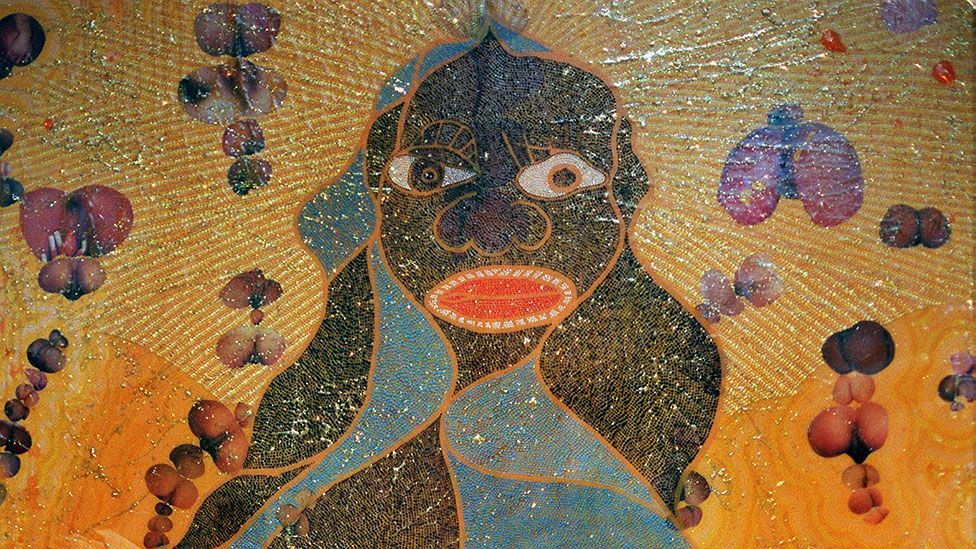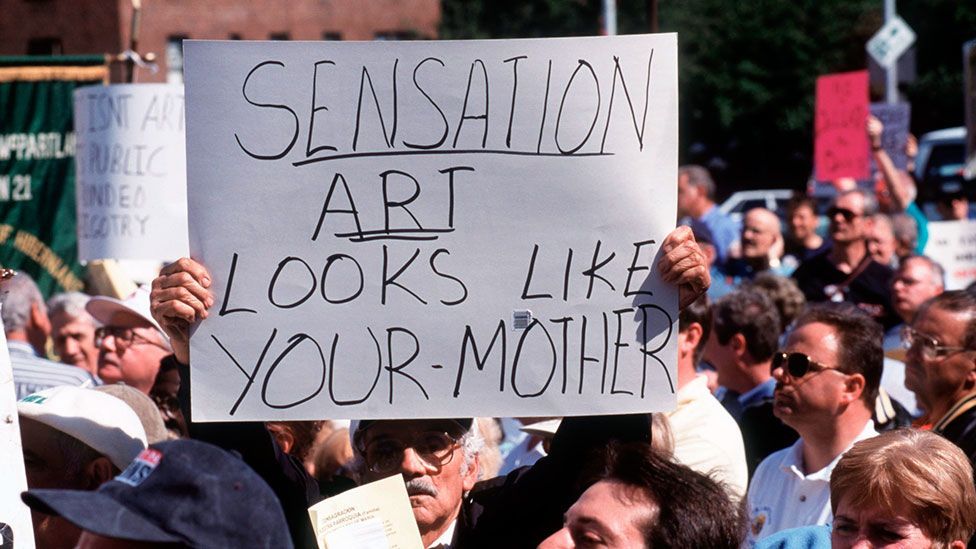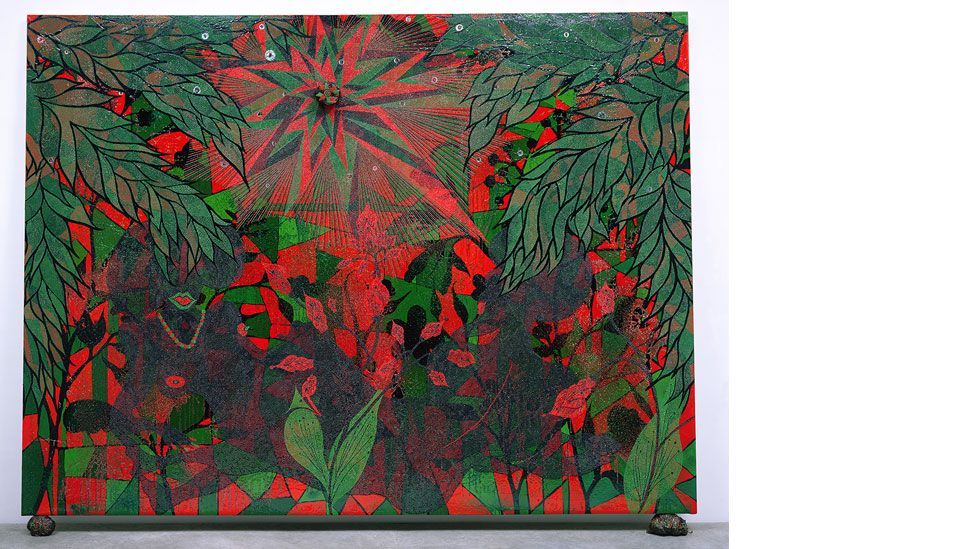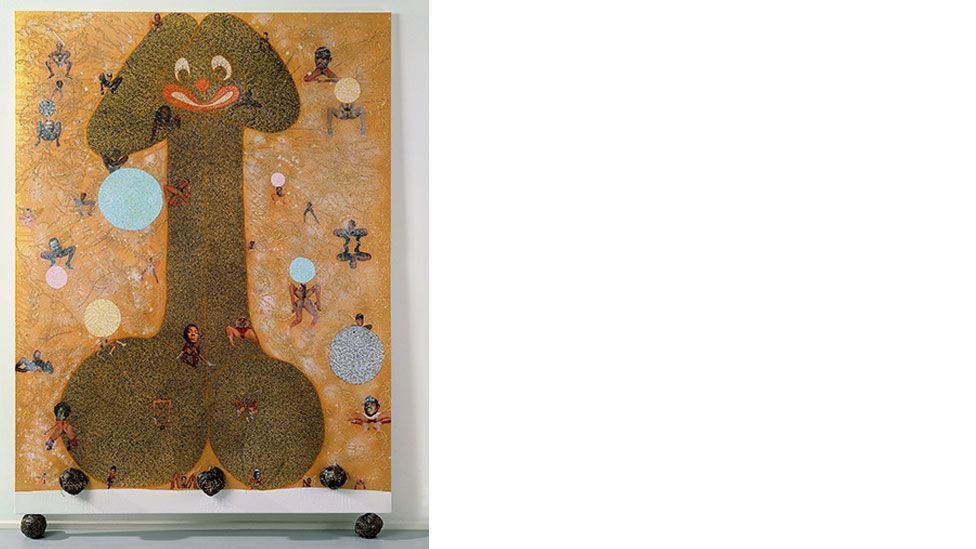When Were Attracted to a Work of Art Because
Chris Ofili: Can art withal stupor us?

A new exhibition by British artist Chris Ofili has been greeted with rapturous praise – where once his work was surrounded by controversy. What'due south changed? Alastair Sooke explains.
"Aggressive", "vibrant", "gorgeous": these were merely three of the adjectives marshalled by American art critics to salute the mid-career retrospective of the British artist Chris Ofili that opened at the New Museum in New York last month. Xv years agone, though, when Ofili participated in a group exhibition at the Brooklyn Museum, the reception he received was anything but rapturous. In fact, it was downright brutal.
The opprobrium was directed at his unforgettable painting The Holy Virgin Mary (1996). In this lustrous yet provocative work, Ofili presents a black Madonna surrounded by fluttering putti against a yellowish-and-orangish groundwork. In the tradition of Western paintings of the Madonna nursing her baby, her blueish robe is parted to reveal one exposed breast. Yet unlike tradition, this breast is a ball of lacquered elephant dung adorned with glitter and carefully attached to the linen support. Similar lumps of manure provide two 'anxiety' for the picture show. On closer inspection, it becomes credible that the putti actually consist of material cut from pornographic magazines, enhancing the overall voluptuousness of the image.

When the Sensation exhibition came to New York, the furore effectually Chris Ofili's painting was intense (James Leynse/Corbis)
The year after information technology was created, The Holy Virgin Mary appeared at the Royal Academy of Arts in London, where it was one of five works by Ofili shown in the infamous Sensation exhibition that featured contemporary art owned by the British collector Charles Saatchi. Not long afterwards, it was exhibited in Germany, when the evidence travelled to Berlin.
Notwithstanding information technology wasn't until the painting arrived in Brooklyn, a year after Ofili had won the prestigious Turner Prize for art, that it finally became newsworthy. "B'KLYN GALLERY OF HORROR. GRUESOME MUSEUM SHOW STIRS CONTROVERSY," ran the headline of an commodity in the New York Daily News that included an inflammatory description of "a painting of the Virgin Mary splattered with elephant dung". (Actually, Ofili didn't "splatter" dung at all, but deployed it with care.)
Things really kicked off, though, the following week. Ten days before Sensation was due to open, during 1 of his daily press conferences, New York City Mayor Rudolph Giuliani lambasted the exhibition as "ill stuff", and singled out The Holy Virgin Mary. "It offends me," Giuliani said, despite the fact that he had not actually seen the painting. "The idea of in the name of art having a city subsidize fine art, so-called works of art, in which people are throwing elephant dung at a flick of the Virgin Mary, is sick," he continued, earlier threatening to remove funding from the Brooklyn Museum unless "the director comes to his senses".
'Elephant in the room'
The furore that followed was deafening and intense, as everyone from Cardinal John O'Connor to First Lady Hillary Clinton contributed to the debate. Eventually, less than 3 months later on Giuliani's remarks, and following record visitor numbers at the Brooklyn Museum, a 72-year-old retired schoolteacher from Manhattan decided to vandalise the painting. Slipping backside a protective Plexiglas shield, he smeared white paint beyond the work of fine art's surface because he considered it "blasphemous".
Fast forward a decade and a half, though, and Ofili is no longer New York'southward bête noire. The Holy Virgin Mary is hanging in the city once more – however nobody seems particularly bothered by its presence. And so what can account for the revulsion it engendered when Sensation came to town in 1999? And what has changed since and then?

Afronirvana, 2002 - this exhibition puts the Virgin Mary in a wider context of religious art (Chris Ofili. David Zwirner, New York / London and Victoria Miro, London)
"We wanted to bring The Holy Virgin Mary back to New York," says the New Museum'south Massimiliano Gioni, who has curated the Ofili exhibition, "because the starting time fourth dimension around it caused a hysteria that had nothing to exercise with the painting in the showtime place."
But if the painting wasn't the trouble, then what was? "There are different possible interpretations," Gioni continues, "just perhaps the actual elephant in the room was that the Virgin Mary was depicted as a black woman. That is what made bourgeois critics most uncomfortable." It has besides been suggested that Giuliani denounced the painting in gild to attract bourgeois votes.
Shock of the few?
This fourth dimension around, Gioni points out, the painting is seen in the wider context of Ofili'south career: "To answer your question about what has changed, one thing we tried to do differently was show the painting with eleven other works from the same period. So it's less of a UFO and more than role of a body of work that offers a complex reflection on the role of images in both creating and criticising heroes and deities. What emerges is that Chris Ofili didn't wake upwardly one morn and say, 'Oh, I'll paint a blasphemous picture to piss people off.' No. It's part of a much wider reflection on religious painting. That makes a huge divergence." He pauses. "Fortunately after xv years we can look at that painting less for its transgressions and more for its accomplishments."
I wonder, though, whether the ability of the painting is diminished if people no longer consider it transgressive. Afterwards all, ane of the strengths of modernistic art used to be its knack for antagonising bourgeois values. As Picasso one time put it, "Art is something subversive… If art is ever given the keys to the city, it volition be because it's been so watered downwardly, rendered and then impotent, that it'south not worth fighting for." With the exhibition at the New Museum, in a sense The Holy Virgin Mary has been given the keys to New York City.
"Perhaps," says Gioni, "but in fine art any transgression eventually gets absorbed and digested, and that'southward non necessarily a form of surrender – it's simply what artists practise: augment the definition of what's possible and what is accepted. Throughout the history of 20th Century art what was shocking at one bespeak becomes normal after a while."

Pimpin' own't easy, 1997 - the YBAs have get associated with media scandal (Chris Ofili, David Zwirner, New York / London and Gimmicky Fine Arts, Berlin)
Still, maybe something else is going on every bit well. Ofili belongs to a generation of artists that emerged in the 1990s and oft attracted controversy in the media. Even so contemporary artists these days are much less probable to cause a stink in the news. Perhaps art has lost its capacity to shock?
"For amend or worse, the generation that was working in the Nineties has been associated with a certain level of if non scandal then at least media exposure," says Gioni. "Think of the YBAs or people like Maurizio Cattelan, and many others. In the following decade, though, younger artists started doing something different."
Gioni mentions Anglo-High german artist Tino Sehgal's contribution to the almanac Unilever Series commission in the Turbine Hall of Tate Modern in London in 2012. Called These Associations, Sehgal's work involved nothing merely "an assembly of participants" who would buttonhole passers-by and engage in moments of group choreography. In other words, it was a functioning, with cypher to "see" in terms of tangible artwork.
"Rather than having a primal spectacle in the mode of Olafur Eliasson [whose monumental Atmospheric condition Project filled the Turbine Hall in 2003], Sehgal went for something that could not exist photographed officially and that refused media-friendliness," says Gioni. "You could say the same for the current Turner Prize [at Tate Britain]. Three out of the 4 shortlisted artists are more cocky-cogitating and less interested in final, grandiose statements. It'south an exhibition of voices mumbling in the night."
If that sounds similar a demolition of this twelvemonth'south Turner Prize show, Gioni doesn't mean information technology that way. "If I were to say I want art to be loud and media-friendly forever, I would be lying," he says. "The dazzler of art is its continuous renewal. Maybe this is the ultimate provocation: that the very definition of art will constantly be renegotiated. That is what pisses some people off, because it makes art almost incommunicable to define."
Alastair Sooke is art critic of The Daily Telegraph.
If you would like to comment on this story or anything else you have seen on BBC Culture, caput over to our Facebook page or message the states on Twitter .
Source: https://www.bbc.com/culture/article/20141125-can-art-still-shock-us
0 Response to "When Were Attracted to a Work of Art Because"
Post a Comment